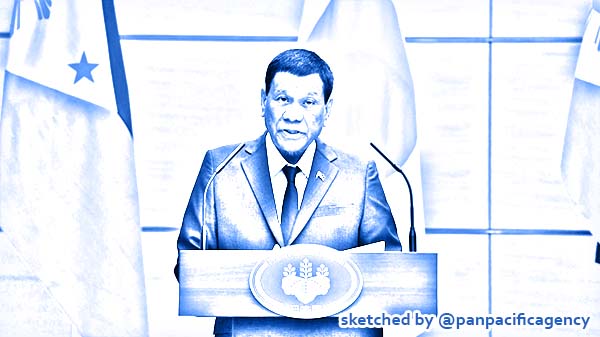All Luzon island’s airports to be closed on Friday, region is under ‘enhanced community quarantine’ in the Philippines

Philippine President Rodrigo Duterte in Tokyo, Japan, May 31, 2019. © Reuters / Kazuhiro Nogi / Pool. Sketched by the Pan Pacific Agency.
MANILA, Mar 17, 2020, PhilStar. All airports in Luzon will be closed once the 72-hour window provided by authorities ends, the Department of Transportation said Tuesday. According to a report by GMA News, no one will be allowed to depart and arrive at Luzon’s gateways once the window hour ends, including overseas Filipino workers and their families, The Philippine Star reported.
The window hour started upon the effectivity of President Rodrigo Duterte’s ‘Enhanced Community Quarantine’ of the entire Luzon island, which began 12 a.m. of March 17 to contain the spread of the new coronavirus.
President Rodrigo Duterte declared an “enhanced community quarantine” over the entire Luzon including Metro Manila as part of a continuous push to contain the spread of the novel coronavirus disease, The Philippine Star reported.
This comes as the latest in a string of measures after Duterte last week approved the hoisting of Code Red Sublevel 2 and placing Metro Manila under community quarantine.
A newly issued memorandum from the Palace on the enhanced quarantine guides government agencies to ensure the following.
Prohibition of mass gatherings and imposition of strict home quarantine among all households
“Movement shall be limited to accessing basic necessities, provision for food and essential health services shall be regulated,” the memorandum states. “And there will be heightened presence of uniformed personnel to enforce quarantine procedures.”
Work-from-home arrangement for the executive branch
“Except the [Philippine National Police, Armed Forces of the Philippines, Philippine Coast Guard and health and emergency frontline services, border control and other critical services which shall ensure a skeletal workforce.”
Only essential establishments are to remain open
“Only those private establishments providing basic necessities and such activities related to food and medicine production i.e. public markets, supermarkets, groceries, convenience stores, hospitals, medical clinics, pharmacies and drug stores, food preparation and delivery services, water-refilling stations, manufacturing and processing plants of basic food products and medicines, power energy, water and telecommunications supplies and facilities shall be open.”
Despite the continued operations of the businesses falling under the above categories, they are required to adopt “strict skeletal workforce to support operations” and staff will also observe social distancing measures. Restaurants, meanwhile, are only allowed to deliver food but not open their establishments to dine-in and walk-in customers, said Cabinet Secretary Karlo Nograles at a press conference.
Export-oriented industries and business process outsourcing companies can also remain operational provided that they offer temporary accommodations to their personnel and observe social distancing as well.
Media practitioners will also be allowed to travel within the quarantine area as long as they are accredited via the Presidential Communications Operations Office.
Suspension of mass public transport facilities
Only private vehicles are allowed if the intention is to secure basic necessities like food and medicines. Only one person per family is allowed to buy essential items.
Employees who would normally take public transportation can be provided with private vehicles by their companies or by the local government unit.
Restricted land, air and sea travel
Outbound passengers can still push through with travel plans within the next 72 hours since the declaration of the enhanced quarantine, that is until Thursday, March 19.
Inbound passengers who are in transit will still be allowed entry but will be subject to quarantine procedures if coming from countries covered by the travel restrictions.
Inbound Filipino citizens and holders of permanent resident visas will also still be allowed entry. They should also expect to be subject to quarantine procedures if coming from countries heavily affected by the outbreak.
“These measures may include, but shall not be limited to, moratorium on lease rentals, advancing a pro-rated thirteenth-month pay, reprieve in utility bills, and assistance to micro-, small- and medium-scale enterprises,” the memorandum states.
The Department of Social Welfare and Development was also tasked to come up with solutions for food assistance to those most affected across Luzon.
Not a ‘total lockdown’
What the Cabinet officials proposed earlier on Monday, however, was a total lockdown of Metro Manila which they did not call an enhanced quarantine.
Presidential spokesperson Salvador Panelo bared that the proposal would be taken up at the meeting of the Inter-Agency Task Force behind the administration’s response to the worsening virus.
“A total lockdown would mean closing of all establishments, it would mean also work or classes are suspended,” he explained to reporters at a briefing earlier that morning at Malacañang.
Panelo assured the public that food supply in a lockdown would not be a cause for concern. “We will not stop the entry of food supply. Markets should also remain open. I think even in Macau, they remained open,” Panelo said.
The Department of Interior and Local Government last week asked the media to use the term “lockdown” sparingly in their reportage as this word could trigger panic.
Interior Undersecretary Jonathan Malaya earlier said that a lockdown would mean that people would be confined and not allowed to leave.
“That’s why the word lockdown is usually used with relation to prisoners. So when China declared a lockdown in Wuhan, their citizens are not allowed to leave those cities and the highways were closed. That’s a lockdown,” he said in a statement sent to reporters.
But at Thursday night’s address, the President admitted, “Ayaw naming gamitin ‘yan. But there is a lockdown.”